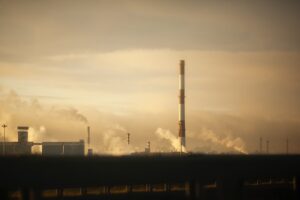Air Pollution and Breast Cancer Risk: Insights from the South Korean E3N Cohort Study.
Breast cancer is a prevalent and concerning health issue affecting women worldwide, especially in industrialized and urban areas. In South Korea, breast cancer is the second most common cancer after thyroid cancer and has been steadily increasing. The rise in breast cancer incidence has been linked to increased exposure to environmental female hormones, and hormone-dependent cancers are becoming more common in industrialized countries.
Recent evidence suggests that air pollution might be a risk factor for breast cancer. Nitrogen oxides (NO2 and NOx), fine particulate matters (PM10 and PM2.5), and polycyclic aromatic hydrocarbons (PAHs) have been associated with breast cancer incidence. The potential mechanisms by which air pollutants affect breast cancer include causing genetic mutations and influencing breast density, a known risk factor. However, there is still inconsistency among studies exploring the link between air pollution and breast cancer risk.
To gain more insights into this issue, researchers conducted an ecological study in South Korea to investigate the associations between various air pollutants (CO, NO2, SO2, O3, PM10) and breast cancer incidence and mortality rates across different regions.
Linking Air Pollution to Breast Cancer Incidence and Mortality
The study analyzed data from all 252 administrative districts in South Korea, including the breast cancer incidence and mortality rates from 2004 to 2016. The results showed significant positive associations between NO2 and PM10 concentrations and breast cancer incidence rate in the female population. This finding is consistent with previous studies reporting higher breast cancer risk associated with air pollution. However, there was no significant association found between air pollution and breast cancer mortality rates, except for PM10.
The Importance of Location and Healthcare Access
The study’s findings add to the growing body of evidence suggesting a potential link between air pollution and breast cancer risk. The association between air pollution and breast cancer incidence may be influenced by the severity of air pollution in different regions. Countries with severe air pollution, such as China or India, might also exhibit similar associations.
It’s crucial to consider that breast cancer incidence and mortality rates may not always show the same patterns. Some districts with high incidence rates may have lower mortality rates due to better access to healthcare resources. Similarly, factors like higher education may increase the incidence rate but lower the mortality rate due to improved disease management and treatment-seeking behaviors.
Limitations and Future Research
While the study provided robust evidence based on a national census database covering the entire female population of South Korea, there were limitations. The unit of analysis was a district, not an individual, so certain individual-level factors, such as histologic subtypes or molecular subtypes of breast cancer, were not considered. Future research could explore the interplay between air pollution and these risk factors.
Moreover, a lag analysis was not performed due to data limitations. More frequent surveys on breast cancer incidence could enable time series analysis and provide richer implications for the field.
Air Pollution and Breast Cancer Risk
The study highlights the importance of investigating the potential impact of air pollution on breast cancer risk. The positive associations between NO2 and PM10 concentrations and breast cancer incidence rate in South Korea suggest that air pollution might play a role in breast cancer development.
As this research expands our understanding, it underscores the need for continuous efforts to reduce air pollution and improve air quality. Cleaner air can contribute not only to better respiratory health but also to potentially lower breast cancer risk.
While the study adds valuable insights, more research is needed to fully comprehend the complex relationship between air pollution and breast cancer risk. As we continue to explore this topic, policymakers and communities can work together to promote environmental initiatives that safeguard public health and support breast cancer prevention and treatment efforts.
Refrence
https://www.nature.com/articles/s41598-020-62200-x
https://doi.org/10.1038/s41598-020-62200-x
Photo by Maxim Tolchinskiy on Unsplash






